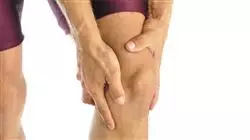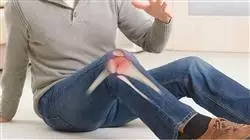University certificate
The world's largest faculty of physiotherapy”
Introduction to the Program
Learn quickly and efficiently how to treat pain in geriatric patients with the support of the most innovative methods in this type of intervention"

The treatment of pain in geriatric patients is supported by the advances and updates that are appearing in this field of work. The physiotherapist needs to keep their skills in line with these developments, in order to improve the patients' quality of life by effectively controlling the pain they feel.
To this end, the professional must assess and examine the patient's resistance and physiological reserves in order to establish the appropriate framework for action, choosing between home care, residential care, day care centers, social centers or private clinics.
It is therefore essential to know the tools of physiotherapy and the appropriateness of their application in each case, such as active exercise, manual therapy and electrotherapy. Being able to work in an interdisciplinary team, with appropriate communication tools, understanding the concept of person-centered care, having the most up-to-date knowledge of support devices and even the support of current technology can be key to success in physical therapy treatment.
Get ahead of the curve in physiotherapy treatment of pain in the elderly"
This Postgraduate certificate in Physiotherapy, Pain and Aging offers you the characteristics of a program of high scientific, educational and technological level. These are some of its most notable features:
- The latest technology in online teaching software
- A highly visual teaching system, supported by graphic and schematic contents that are easy to assimilate and understand
- Practical cases presented by practising experts
- State-of-the-art interactive video systems
- Teaching supported by telepractice
- Continuous updating and recycling systems
- Autonomous learning: full compatibility with other occupations
- Support groups and educational synergies: questions to the expert, debate and knowledge forums
- Communication with the teacher and individual reflection work
- Content that is accessible from any fixed or portable device with Internet connection
- Complementary documentation banks permanently available, even after the course
A study that will cover the different pathologies and situations of intervention with geriatric patients with a focus on the practical reality of working in this field"
The program’s teaching staff includes professionals from the sector who contribute their work experience to this program, as well as renowned specialists from leading societies and prestigious universities.
The multimedia content, developed with the latest educational technology, will provide the professional with situated and contextual learning, i.e., a simulated environment that will provide immersive learning programmed to train in real situations.
This program is designed around Problem-Based Learning, whereby the professional must try to solve the different professional practice situations that arise during the academic year. For this purpose, the student will be assisted by an innovative interactive video system created by renowned and experienced experts
A methodological approach supported by teaching techniques proven for their effectiveness, allowing you to learn in a dynamic and efficient way"

With the support of high-quality audiovisual systems, the purpose of this course is that you not only acquire the knowledge, but that, upon completion, you possess the working skills you need to excel in this field”
Why study at TECH?
TECH is the world’s largest online university. With an impressive catalog of more than 14,000 university programs available in 11 languages, it is positioned as a leader in employability, with a 99% job placement rate. In addition, it relies on an enormous faculty of more than 6,000 professors of the highest international renown.

Study at the world's largest online university and guarantee your professional success. The future starts at TECH”
The world’s best online university according to FORBES
The prestigious Forbes magazine, specialized in business and finance, has highlighted TECH as “the world's best online university” This is what they have recently stated in an article in their digital edition in which they echo the success story of this institution, “thanks to the academic offer it provides, the selection of its teaching staff, and an innovative learning method aimed at educating the professionals of the future”
A revolutionary study method, a cutting-edge faculty and a practical focus: the key to TECH's success.
The most complete study plans on the university scene
TECH offers the most complete study plans on the university scene, with syllabuses that cover fundamental concepts and, at the same time, the main scientific advances in their specific scientific areas. In addition, these programs are continuously being updated to guarantee students the academic vanguard and the most in-demand professional skills. In this way, the university's qualifications provide its graduates with a significant advantage to propel their careers to success.
TECH offers the most comprehensive and intensive study plans on the current university scene.
A world-class teaching staff
TECH's teaching staff is made up of more than 6,000 professors with the highest international recognition. Professors, researchers and top executives of multinational companies, including Isaiah Covington, performance coach of the Boston Celtics; Magda Romanska, principal investigator at Harvard MetaLAB; Ignacio Wistumba, chairman of the department of translational molecular pathology at MD Anderson Cancer Center; and D.W. Pine, creative director of TIME magazine, among others.
Internationally renowned experts, specialized in different branches of Health, Technology, Communication and Business, form part of the TECH faculty.
A unique learning method
TECH is the first university to use Relearning in all its programs. It is the best online learning methodology, accredited with international teaching quality certifications, provided by prestigious educational agencies. In addition, this disruptive educational model is complemented with the “Case Method”, thereby setting up a unique online teaching strategy. Innovative teaching resources are also implemented, including detailed videos, infographics and interactive summaries.
TECH combines Relearning and the Case Method in all its university programs to guarantee excellent theoretical and practical learning, studying whenever and wherever you want.
The world's largest online university
TECH is the world’s largest online university. We are the largest educational institution, with the best and widest online educational catalog, one hundred percent online and covering the vast majority of areas of knowledge. We offer a large selection of our own degrees and accredited online undergraduate and postgraduate degrees. In total, more than 14,000 university degrees, in eleven different languages, make us the largest educational largest in the world.
TECH has the world's most extensive catalog of academic and official programs, available in more than 11 languages.
Google Premier Partner
The American technology giant has awarded TECH the Google Google Premier Partner badge. This award, which is only available to 3% of the world's companies, highlights the efficient, flexible and tailored experience that this university provides to students. The recognition as a Google Premier Partner not only accredits the maximum rigor, performance and investment in TECH's digital infrastructures, but also places this university as one of the world's leading technology companies.
Google has positioned TECH in the top 3% of the world's most important technology companies by awarding it its Google Premier Partner badge.
The official online university of the NBA
TECH is the official online university of the NBA. Thanks to our agreement with the biggest league in basketball, we offer our students exclusive university programs, as well as a wide variety of educational resources focused on the business of the league and other areas of the sports industry. Each program is made up of a uniquely designed syllabus and features exceptional guest hosts: professionals with a distinguished sports background who will offer their expertise on the most relevant topics.
TECH has been selected by the NBA, the world's top basketball league, as its official online university.
The top-rated university by its students
Students have positioned TECH as the world's top-rated university on the main review websites, with a highest rating of 4.9 out of 5, obtained from more than 1,000 reviews. These results consolidate TECH as the benchmark university institution at an international level, reflecting the excellence and positive impact of its educational model.” reflecting the excellence and positive impact of its educational model.”
TECH is the world’s top-rated university by its students.
Leaders in employability
TECH has managed to become the leading university in employability. 99% of its students obtain jobs in the academic field they have studied, within one year of completing any of the university's programs. A similar number achieve immediate career enhancement. All this thanks to a study methodology that bases its effectiveness on the acquisition of practical skills, which are absolutely necessary for professional development.
99% of TECH graduates find a job within a year of completing their studies.
Postgraduate Certificate in Physiotherapy, Pain and Aging
The world's population is aging at an accelerated rate, which represents a great challenge for the healthcare system. In the case of the elderly, pain becomes a frequent and limiting problem that significantly affects their quality of life. This is why it is essential for physical therapists to be aware of recent techniques and procedures to alleviate ailments in the geriatric patient. With this objective in mind, TECH has developed the Postgraduate Certificate in Physiotherapy, Pain and Aging, which will put you at the forefront of the profession online and without leaving your home.
Update yourself without moving to a study center.
Do you want to assimilate the sophisticated methods to establish the evaluation of pain or the state-of-the-art techniques to carry out the physiotherapeutic treatment of pain in the geriatric patient? This Postgraduate Certificate will be your best ally. Get a complete update in this field to improve your professional performance, from the hand of teachers with extensive experience in the management of injuries in the elderly.







